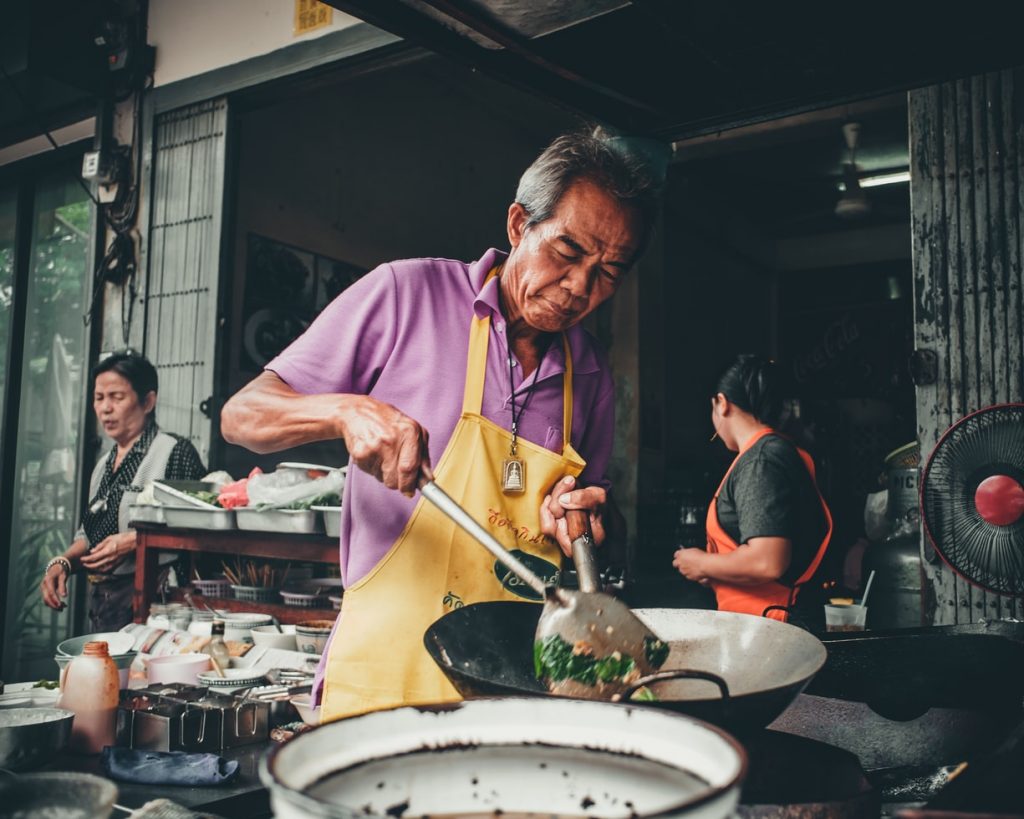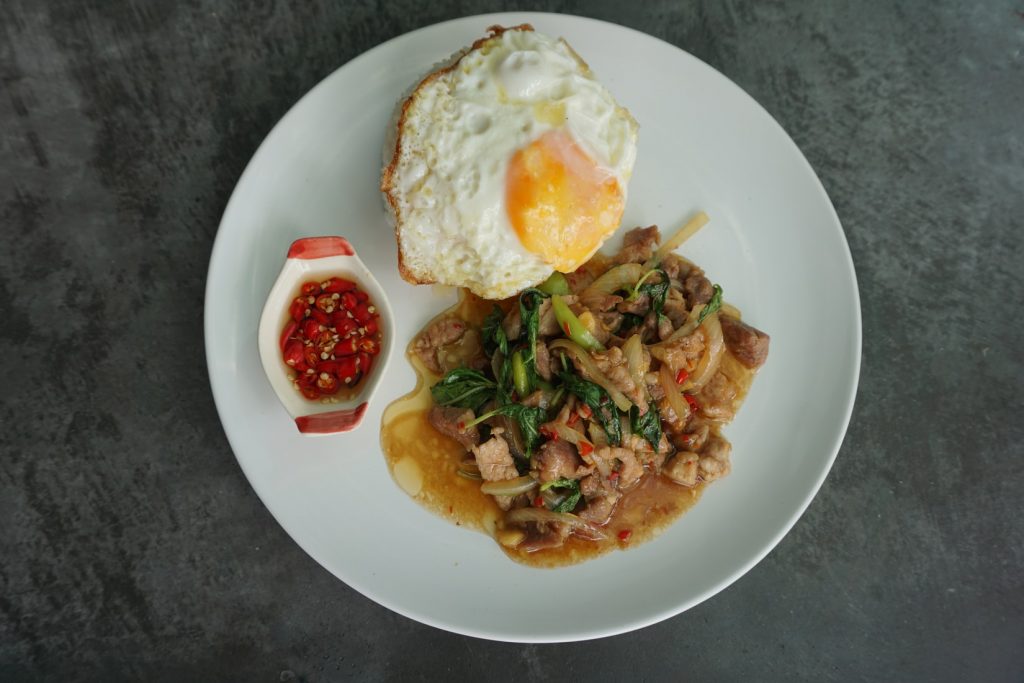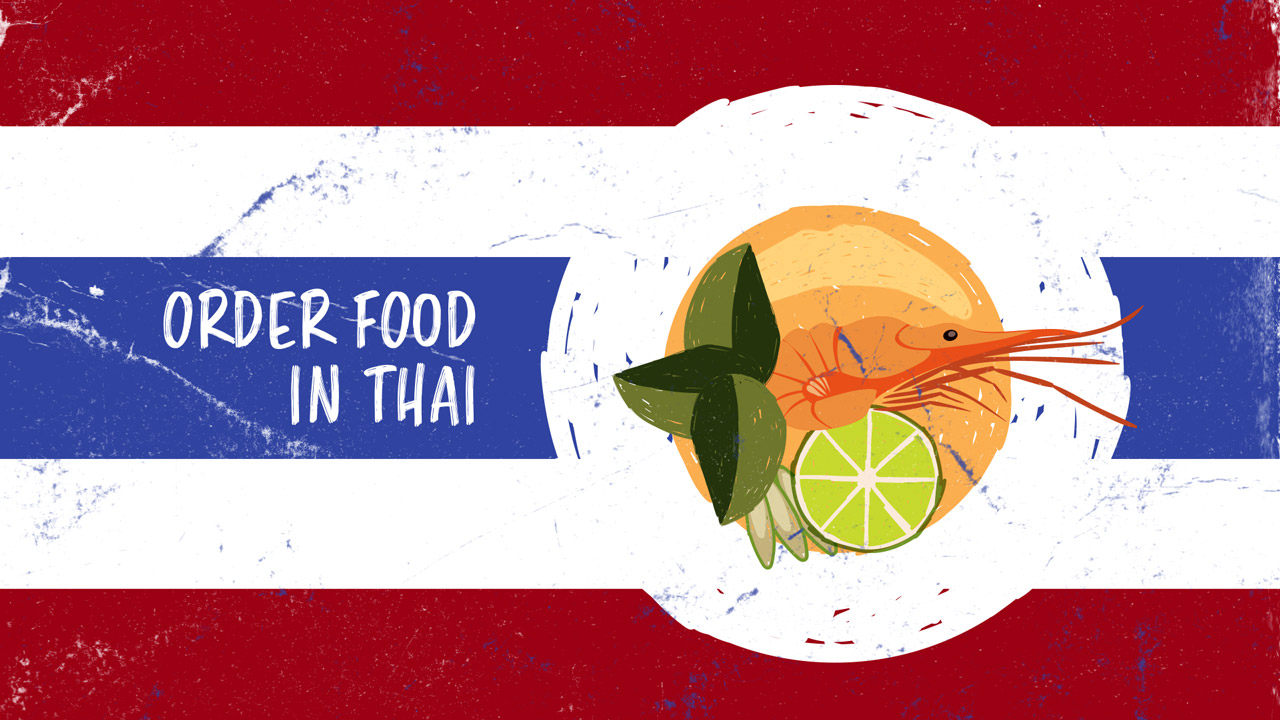How to Order Your Favorite Thai Dishes IN Thai
Thailand is a beautiful country with a reputation for picturesque beaches, kind hospitality, and perhaps most notably, delicious food. Thai food has made its way around the globe and into the hearts of millions of hungry patrons who have come to love the tasty and often chili-laden cuisine.
Ordering your food in Thai is an excellent opportunity to flex your language-learning muscles and it also gives you a great excuse to head to your favorite Thai restaurant for a delicious curry or stir-fry.
This article will teach you how to order your favorite Thai dishes in Thai and also help you to understand more about Thai food culture.
Table of contents
Ordering Your Food
When ordering food in a Thai Restaurant the first thing you need to decide is, will you be ordering for yourself or for the table?
The reason this is important is because, in Thai, you can order the same dish two different ways:
- ราดข้าว (raat khaao) meaning “over rice,” and usually for a single person.
- กับข้าว (gap khaao) meaning “with rice,” a much larger portion that can be shared with others.
This is applicable to dishes that come with rice, such as ข้าวผัด (khaao pad), also known as “Fried Rice” or ผัดกะเพรา (pad ga-prao), which is sometimes called “Spicy Basil Stir-Fry”.
Once you’ve decided on your portion size, your next decision is, of course, what you’d like to order. Here are some of the most popular Thai Dishes:
- ข้าวผัด (khaao pad) – “Fried Rice”
- ผัดซีอิ๊ว – Pad See Ew
- ผัดกะเพรา – Pad Ga Prao, or “Spicy Basil”
- ผัดขี้เมา – Pad Kii Mao, or “Drunken Noodles”
- แกง (geng) – “Curry”
- ต้มยำ – Tom Yum
To order a dish you simply use the word เอา (ao), the verb “to want”.
You can say: เอาผัดซีอิ๊วครับ (ao pad see ew krap) ครับ (“I’d like Pad See Ew please”). ครับ (krap) is the polite way to end your sentence if you’re a male. You would say ค่ะ (ka) instead if you’re female, which acts almost like “please”.
The phrase mentioned above will help your waiter or waitress know which dish you want, but you still need to let them know which protein you would like.
The most common proteins for Thai food include:
- หมู (moo) – “pork”
- ไก่ (gai) – “chicken” ทะเล (tah-leh) – “mixed seafood”
- กุ้ง (goong) – “shrimp”
Less common, but can be ordered in different regions of Thailand and some restaurants: เนื้อวัว (new-uh woo-ah, “beef”).
The proper way to explain which protein you’d like is to say it after the name of the dish.
So if you’d like to order “Chicken Fried Rice” you would say เอาข้าวผัดไก่ครับ (ao khaao pad gai krap, or ka for female speakers). Quite literally, this translates to: “want rice fried chicken please”.
If you want to make sure that the waiter or waitress know you only want a single portion, you can add ราดข้าวครับ (raat khaao krap, or ka) after.
So the formula is simple:
เอา (ao) + name of dish + protein + ครับ (krap, or ka if you’re female) + ราดข้าวครับ (raat khao krap, or ka) for a single portion or กับข้าว (gap khaao) for a dish to share.
Can You Eat Spicy?
The next consideration when it comes to ordering your food is, how spicy would you like it? In Western countries, if you go to a Thai Restaurant you will often be asked to describe your desired spice level with a number from 1-10.
In Thailand, generally, you will not be asked this question. If you order ผัดกะเพรา (pad ga prao) in Southern Thailand, where they love their Thai chilis, you can expect it to be quite spicy.
There is however a way to describe how spicy you would like your food in a situation like this. The word เผ็ด (pet) means spicy.
- If you want a little bit of spice you can use the phrase เผ็ดนิดหน่อย (pet nit noi), meaning “a little bit spicy”.
- If you want as little spice as possible, you can use the phrase ไม่เผ็ดเลย (mai pet lui), meaning “not spicy at all”.
- You can also use the phrase: ไม่ใส่พริกเลย (mai sai prik lui), meaning “don’t put any peppers in at all”.
If you are quite sensitive to spicy food, the last phrase in particular will help make sure the dish you order remains edible for you.
If you are a foreigner and enjoy the spiciness of Thai dishes, you can order as normal and expect to eat a dish as the locals would have it.
On some occasions you may even have the แม่ครัว (meh kruua) or “female chef” ask you the question: กินเผ็ดได้ไหม (gin pet dai mai?) meaning: “Can you eat spicy food?”
If you enjoy spicy food and want your food as the locals would order it, you can respond with กินเผ็ดได้ (gin pet dai), meaning you “can eat spicy food”.
If you are concerned about whether you can handle the spice, you can use the phrase เผ็ดนิดหน่อย (pet nit noi) mentioned above to let them know you’d like it just a little spicy. Usually, it will be adjusted a bit for you.
Don’t Forget Your Veggies
If you are a vegetarian or prefer to not eat meat, this is certainly possible. There are a variety of delicious Thai dishes that contain only vegetables. However, if you are ordering at a restaurant in Thailand, this can sometimes be a bit tricky.
The vast majority of Thais will eat their meals with a protein such as chicken or pork. It is possible to order a dish without meat and to have only vegetables but you need to ask for this clearly.
Often, cooks will be concerned that they are not feeding you enough and not giving you a full and complete meal. You might need to repeat yourself to make sure they understand you would prefer only vegetables but usually this is not a problem.
The word for vegetables is ผัก (pak).
You can use this word the same way you would use pork or chicken to explain that you would like only vegetables.
For example: เอาผัดขี้เมาผัก (ao pad kii mao pak), meaning: “I’d like Drunken Noodles with vegetables.”

Thai Food Culture
Food etiquette is something that can vary greatly depending on where you’re from and where you’re visiting.
If you are eating in a Western restaurant, for instance, generally it is considered respectful and considerate to wait for everyone at the table to receive their food before eating.
In local restaurants in Thailand, this is often not the case. When you receive your food, it is quite normal and acceptable to eat as your food comes, even if others are waiting to receive their dish.
Part of the reason for this is that at smaller local restaurants there might be only one or perhaps two cooking stations in which only one dish at a time can be made. This means that it might take a while for the dishes that everyone has ordered at your table to be ready and delivered.
Instead of waiting for everyone and eating a cold dish, it is quite normal for people to eat their food as it is received.

Secret Menu Items
Who doesn’t love a secret menu? In Thai restaurants, there are two “secret” menu items that usually won’t appear on the menu but that can be ordered everywhere.
The first item is known as ไข่ดาว (“kai daao”) or “fried egg”. If you would like a delicious fried egg served with your stir fry you can simply add ไข่ดาว (“kai daao”) to the end of your order.
So let’s say you want a Pork Spicy Basil Stir-Fry with a fried egg on top of your rice. That would like this: เอาผัดกะเพราหมูไข่ดาวครับ (ao pad ga prao moo kai daao krap, or ka).
The second “secret” menu item that can be ordered throughout Thailand has to do with how hungry you are.
If you are especially hungry and don’t feel like the standard single serving of a ราดข้าว (raat khaao) dish will satisfy you, you can order a dish พิเศษ (pii-set) literally meaning special. This is a larger than standard portion of a meal but not quite as large as a กับข้าว (gap khaao) portion.
Similar to ไข่ดาว (kai daao), if you would like your dish to be พิเศษ (pii-set) or super-sized we could say, you simply add the phrase to the end of the order.
If you’d like to order Shrimp Fried Rice พิเศษ (pii-set) you can simply say: เอาข้าวผัดกุ้งพิเศษครับ (ao khaao pad gung pi-set krap).
How to Ask For Your Bill
In Thailand you are generally not rushed to leave the restaurant and you will need to ask for the check yourself.
There is a simple phrase that you can use that works no matter where you are: ขอเช็คบิลด้วย (kor check-bin duuai) meaning: “Can I please have the bill?”
Tipping
Outside of resort areas, hotels and Western-style restaurants, there is not much of a tipping culture in Thailand. If you were to eat at a local Thai restaurant, tips would not be expected. However, when your change is brought back to you, some will leave the coins as a small tip of usually 1-10 baht per person.
Of course, please respect the local tipping culture wherever you are, just because you’re eating at a Thai restaurant does not mean that you shouldn’t respect your local customs and culture.
Ready to Eat
There you have it. With this guide you have everything you need to order your favorite dish from your local Thai restaurant.
There’s no need to feel intimidated, you’ll no doubt make mistakes and things won’t always come out the way you want them to, but the effort to try to speak Thai will always be appreciated and will make that delicious food just that extra bit better.



Social